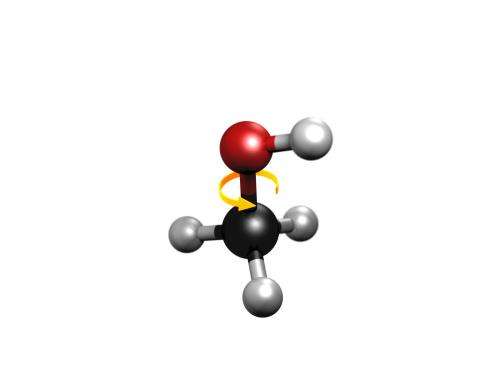Alcohol constrains physical constant in the early universe

(Phys.org)—Radio-astronomical observations of a distant galaxy indicate that the ratio of the proton's mass to that of the electron has hardly changed over cosmic history. This fundamental constant of nature has changed by 10-7 or less, equivalent to a maximum of one hundred thousandth of a percent, in the past 7 billion years. Scientists from VU University Amsterdam and the Max-Planck-Institut für Radioastronomie (MPIfR) used the Effelsberg 100-m radio telescope to obtain accurate measurements of methanol absorption at several characteristic frequencies. Methanol, the simplest form of the family of alcohol molecules, was observed in a distant galaxy at redshift z = 0.89 toward the quasar system PKS 1830-211. The resulting stringent limit on the proton-to-electron mass ratio shows that molecules and molecular matter are, with high accuracy, the same now as 7 billion years ago. The work is published online in Science Express on 13 Dec. 2012.
A fundamental constant such as the proton-to-electron mass ratio cannot be calculated from any currently known theory, it can only be measured. The Earth-bound experiments agree upon its value but the explanation for it is still missing. Therefore, a possibility remains that the proton-to-electron mass ratio was different in different places in the universe or at different epochs in cosmic history. The methanol molecule is a very sensitive probe for detecting a drift of the proton-electron mass ratio. Some lines in the microwave spectrum of this molecule would undergo a rather large shift upon a variation of the proton-to-electron mass ratio (designated by the lowercase Greek letter mu), while other lines are not affected (so-called "anchor lines"). Recently the Amsterdam group found that the hindered internal rotational motion in molecules such as methanol (in fact also a quantum tunneling process) can give rise to very high sensitivity coefficients. The sensitivity of each spectral line can be expressed in a value K, which may be calculated.

"This idea makes the methanol molecule an ideal probe to detect a possible temporal variation in the proton-electron mass ratio", says Wim Ubachs, Professor at VU University Amsterdam and Head of its Department of Physics. "We proposed to search for methanol molecules in the far-distant universe, to compare the structure of those molecules with that observed in the present epoch in laboratory experiments."
The team performed an investigation of a galaxy known as a "molecular factory" in the line-of-sight of a strong radio source (PKS 1830-211). The molecular factory is known to be at a distance of 7 billion light-years from Earth. The search was for four lines in the radio spectrum of the methanol molecule. Observations with the 100-m radio telescope at Effelsberg/Germany were carried out between December 2011 and April 2012 and all four lines could be detected.
"Coming from optical astronomy it was an interesting experience to perform observations at such long wavelengths", says Julija Bagdonaite, a PhD student at VU University Amsterdam and lead author of the paper. "The absorptions of the radio waves have occurred 7 billion years ago, and the radio waves traveling to Earth carry the fingerprint of the methanol molecules in the distant past."
From an analysis of the quantum level structure of the methanol molecule it can be derived that two of the lines in the spectrum, both observed near 25 GHz, behave like anchor lines. Their sensitivity to a drifting mu is small; the value is K = -1 for these lines. The other two lines are sensitive to a drifting constant; the line at 32 GHz has K = -7.4, while the line observed at 6.5 GHz is most sensitive with K = -32.8. The observed frequencies are not the true frequencies at which the radiation was emitted; in the meantime (of 7 billion years) the universe has expanded and therefore all the lines have been redshifted by a factor of (1+z), where z = 0.88582 for the absorbing galaxy. The relation between the redshift parameter z and the look-back time in the universe follows from cosmological models on redshift.
"The PKS source is by far the best of our targets to investigate the validity of local physics in exotic environments", says Christian Henkel from MPIfR. "It would be highly desirable to identify similar objects at even larger look-back times."
If systematic effects of the observations are included in these data a final result is obtained from the study: the fundamental constant of nature, the proton-electron mass ratio, has changed by no more than 10-7 over the past 7 billion years. This result can be interpreted as: the structure of molecular matter, as probed from its spectrum, is almost the same as it was 7 billion years ago; it has changed by a one hundred thousandth of a percent or less.
"If you see any variations in that fundamental constant, then you would know that something is wrong in our understanding of the foundations of physics", concludes Karl Menten, Director at MPIfR and head of the Institute's Millimeter and Submillimeter Astronomy Department. "In particular, it would imply a violation of Einstein's Principle of Equivalence which is at the heart of his General Theory of Relativity."
Observations were carried out at Effelsberg by a research team consisting of Wim Ubachs (Principal Investigator), Julija Bagdonaite, Paul Jansen and Rick Bethlem (all VU University Amsterdam) in collaboration with Christian Henkel and Karl Menten (MPIfR, Bonn, Germany).
More information: A Stringent Limit on a Drifting Proton-to-electron Mass Ratio from Alcohol in the Early Universe, Julija Bagdonaite, Paul Jansen, Christian Henkel, Hendrick L. Bethlem, Karl M. Menten, Wim Ubachs: Science Express, December 13, 2012. DOI: 10.1126/science.1224898
Journal information: Science Express
Provided by Max Planck Society


















